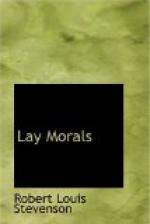Next night they reached the village of Colinton, four miles from Edinburgh, where they halted for the last time. {4h}
CHAPTER IV—RULLION GREEN
’From Covenanters with uplifted hands,
From Remonstrators with associate bands,
Good Lord, deliver us!’
Royalist Rhyme, Kirkton, p. 127.
Late on the fourth night of November, exactly twenty-four days before Rullion Green, Richard and George Chaplain, merchants in Haddington, beheld four men, clad like West-country Whigamores, standing round some object on the ground. It was at the two-mile cross, and within that distance from their homes. At last, to their horror, they discovered that the recumbent figure was a livid corpse, swathed in a blood-stained winding-sheet. {5a} Many thought that this apparition was a portent of the deaths connected with the Pentland Rising.
On the morning of Wednesday, the 28th of November 1666, they left Colinton and marched to Rullion Green. There they arrived about sunset. The position was a strong one. On the summit of a bare, heathery spur of the Pentlands are two hillocks, and between them lies a narrow band of flat marshy ground. On the highest of the two mounds—that nearest the Pentlands, and on the left hand of the main body—was the greater part of the cavalry, under Major Learmont; on the other Barscob and the Galloway gentlemen; and in the centre Colonel Wallace and the weak, half-armed infantry. Their position was further strengthened by the depth of the valley below, and the deep chasm-like course of the Rullion Burn.
The sun, going down behind the Pentlands, cast golden lights and blue shadows on their snow-clad summits, slanted obliquely into the rich plain before them, bathing with rosy splendour the leafless, snow-sprinkled trees, and fading gradually into shadow in the distance. To the south, too, they beheld a deep-shaded amphitheatre of heather and bracken; the course of the Esk, near Penicuik, winding about at the foot of its gorge; the broad, brown expanse of Maw Moss; and, fading into blue indistinctness in the south, the wild heath-clad Peeblesshire hills. In sooth, that scene was fair, and many a yearning glance was cast over that peaceful evening scene from the spot where the rebels awaited their defeat; and when the fight was over, many a noble fellow lifted his head from the blood-stained heather to strive with darkening eyeballs to behold that landscape, over which, as over his life and his cause, the shadows of night and of gloom were falling and thickening.
It was while waiting on this spot that the fear-inspiring cry was raised: ‘The enemy! Here come the enemy!’
Unwilling to believe their own doom—for our insurgents still hoped for success in some negotiations for peace which had been carried on at Colinton—they called out, ‘They are some of our own.’
’They are too blacke ’ (i.e. numerous), ’fie! fie! for ground to draw up on,’ cried Wallace, fully realising the want of space for his men, and proving that it was not till after this time that his forces were finally arranged. {5b}




